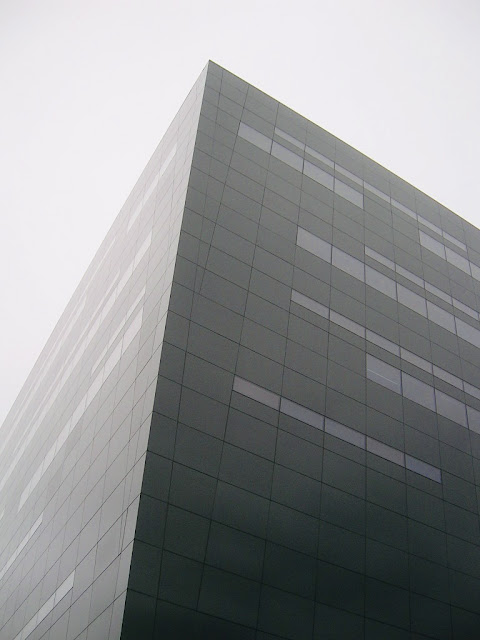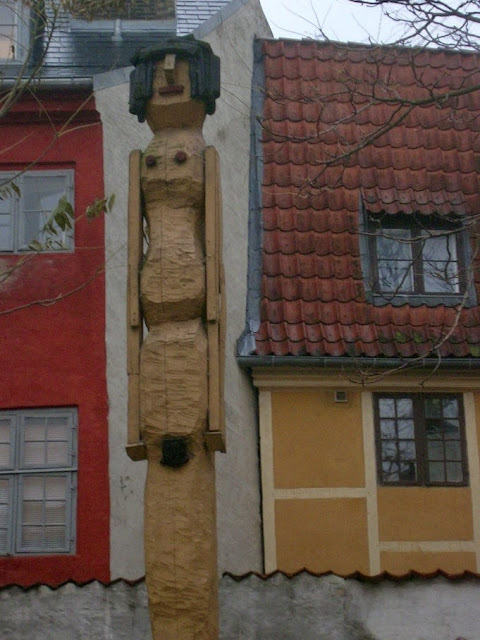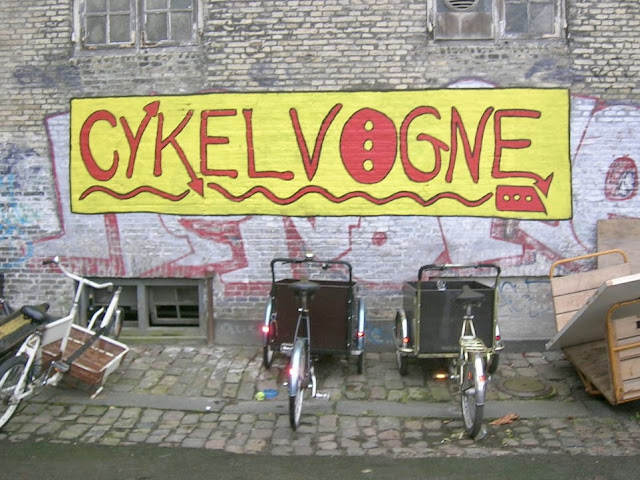"You can't see everything," Chris demurred when I asked if he and Dan wanted to check out the Little Mermaid before saying goodbye to Copenhagen. You can if you get up early enough before your departure flight. I was determined to say hello to a landmark where I had been photographed as a child, not old enough to remember the experience but seeing the proof for decades. She'd been decapitated twice since!
My rushed, pre-dawn walk from the hotel to the Inner Harbor took me past the spanking new, ultra deluxe (and expensive) opera house. It had been completed only the month before. Divas wouldn't begin performing until January.
After a two-year break, we had resumed our traditional of alphabetical Thanksgiving travel. Having a digital camera to document it increased both the quantity and quality of the photos.
Denmark introduced us to the concept of "hygge, " supercharged here with some mulled wine. The election of George W. Bush earlier in the month had us prematurely pretending to be Canadian.
While waiting for Dan to arrive, Chris and I went to see "The Birth of Cool" at the Design Museum Denmark.
Evidence of good design--often sleek-- was everywhere we looked. I recalled the Danish modern furniture--including a bed and headboard and a Grundig home entertainment system--my mother had purchased for our suburban home upon returning to the United States.
Tivoli Gardens topped my list of places to re-visit.
The full racks outside the main train station indicated the popularity of bicycle commuting.
Clueless American pedestrians are more likely to get hit by a bike than a car.
It looked as if even models pedalled to work.
The gray skies contrasted with the colorful buildings and boats along the Nyhavn Canal.
Early in the trip, we hit the Glyptotek (which means storage place for carved figures in Danish) built in the late 19th century by the founder of Carlsberg Breweries. Beer money has rarely been so beautifully spent.
Thought bubble: "Maybe he's a grower, not a shower."
We also stopped at the Royal Library.
At the time, Dan was a law librarian supervising the transition to digital tech at a law firm in New York City.
The Jewish Museum must have been closed. In any case, I have no recollection of a visit.
Four entwined dragons' tails form the spire of the Børsen, the 17th-century building that once housed the Danish stock exchange.
A gargoyle guarded Copenhagen's Town Hall.
We also ventured north of the city to Rungstedlund, the home where Karen Blixen--better known as Isak Dinesen--spent much of her life before and after leaving Kenya.
Dan and Chris posed in front of a memorial to Johannes Ewald, an 18th-century Danish poet and dramatist who preceded Blixen at Rungstedlund while being treated for gout.
Jet lag and early nightfall caught up with us at the Louisiana Museum of Modern Art, situated on the Øresund, the strait that separates Denmark from Sweden. After a tasty late lunch in the cafe, we called it a day.
The next morning, we took a train across the Øresund Bridge to Malmo.
A Swedish artist created the Knotted Gun, a monument to non-violence, after Mark David Chapman used a gun of the same make and model to murder John Lennon outside the Dakota, one of the more traumatic events of my young adulthood. The original sculpture sits outside the United Nations. Although copies are displayed in more than 30 cities worldwide, including Berlin, Cape Town and Mexico City, I've never seen it anywhere else.
Chris, who has Swedish ancestry, guided us to St. Peter's Church which dates back to the 14th century.
Lilla Torg, a small square in Old Town, was more my speed.
We spent time browsing in Peak Performance, a Swedish sporting goods store. I bought some underwear for Florian, whom I had met only days before leaving New York.
On our return trip to Copenhagen, we encountered a Swedish border patrol agent who didn't look Scandanavian
. . . and a chatty passenger who wasn't shy about sharing her right-wing political views.
Chris and Dan indulged my desire to see Freetown Christiania, an anarchist commune that took root when squatters settled in an abandoned military base the same year I started college. Until 2024, dealers still sold hash openly on Pusher Street which made it a worldwide tourist destination prior to the liberalization of drug laws.
For much of its history, residents ignored Danish law and Christiania attracted drug users and motorcycle gangs
. . . in addition to artisans like this metal worker and other idealists who abhorred "straight" society. I purchased a wire ornament shaped like a conical Christmas tree and decorated with tiny stars which left a much greater impression than the pricey gold bauble I picked up earlier at Georg Jensen.
If graffiti reflects mood, many of Christiana's residents could have benefitted from mood stabilizers.
But creativity and tolerance remained core values of nearly a thousand squatters.
In 2012 the Danish government forced them to make a Hobson's choice: either buy the land they had long occupied rent-free or vacate.
Land ownership improved the quality of construction, including eco-friendly homes. Surprise, surprise: the young anarchists aged into the bourgeoisie.
I loved Christiania. My traveling companions did not.
More ABC Thanksgiving Travel:
*exceptions make the rule












.JPG)








.JPG)
.JPG)






.JPG)


.JPG)
























No comments:
Post a Comment